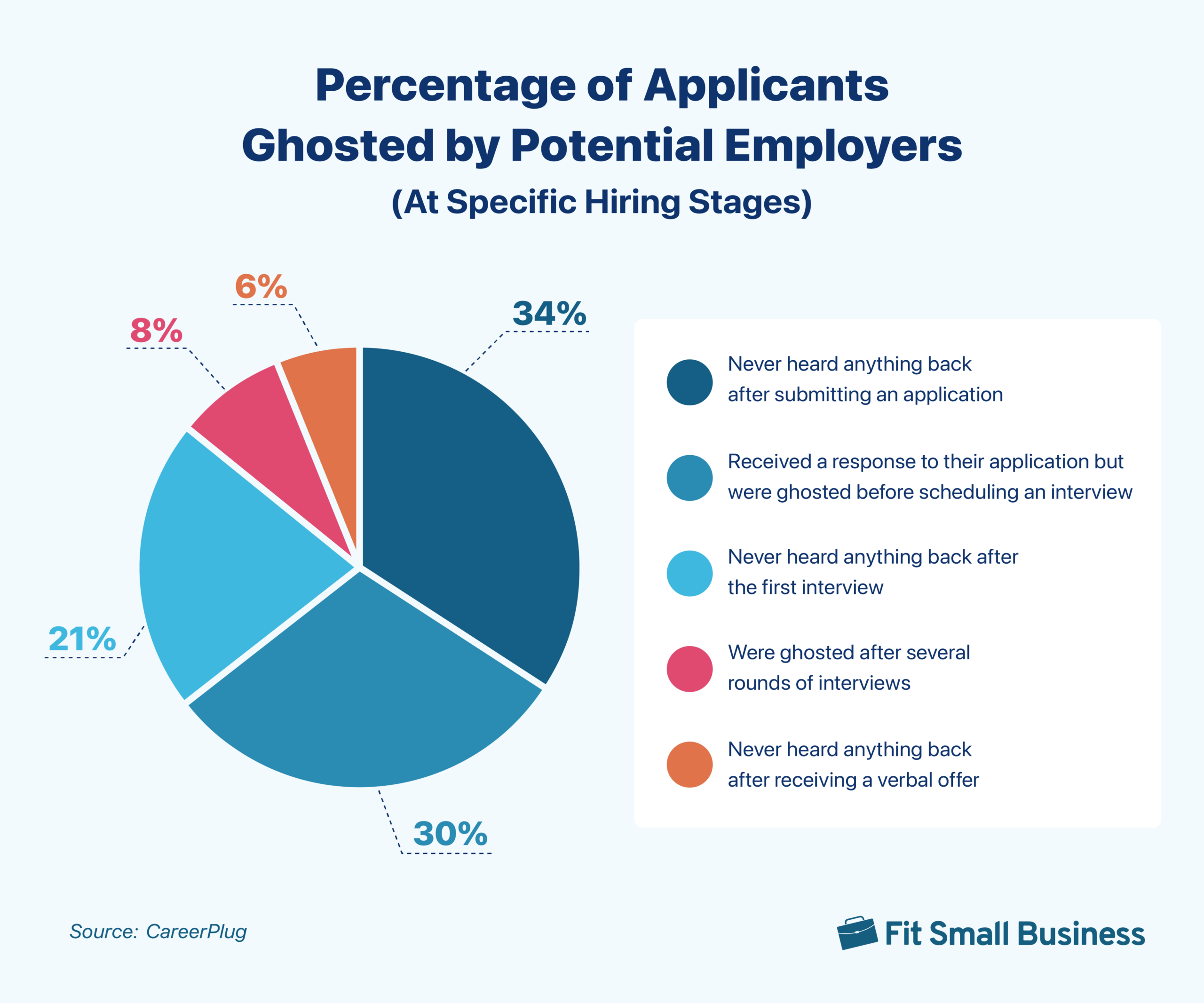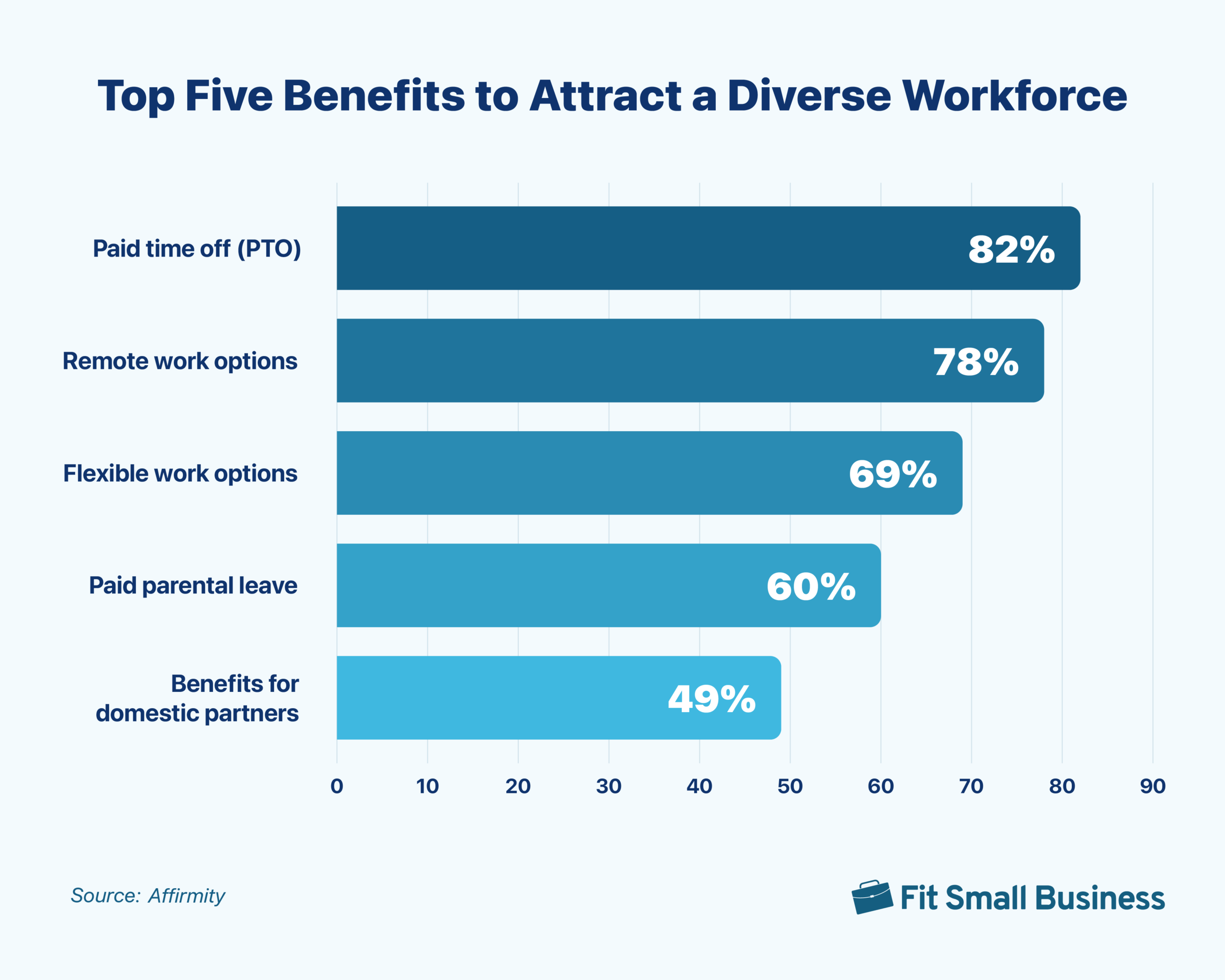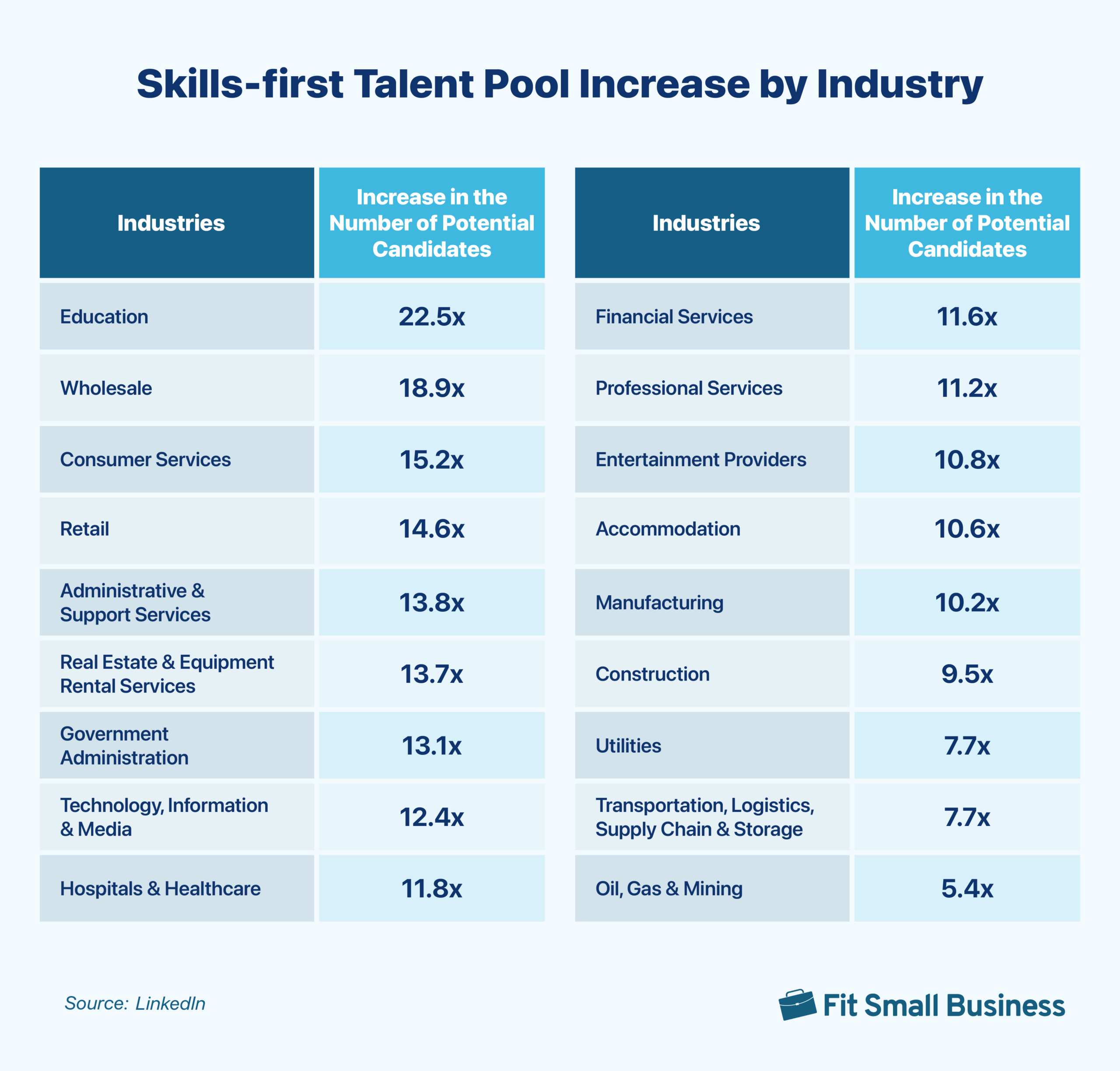The most current recruitment statistics illustrate dramatic changes in hiring, especially over the last few years. These changes are influenced by different factors—some by emerging trends in applicant behavior and HR practices and others by societal and environmental shifts.
Key Takeaways
- Job seekers consider WFH (work from home) flexibility and company culture right after salary.
- A skills-based hiring approach can increase your talent pool by an average of 10x.
- Artificial intelligence tools are expected to transform talent acquisition processes.
- A negative interview experience may result in a declined job offer.
- Many applicants find job openings on social media.
Using data as a guide, your organization can adapt and stand out to potential employees. Here are the most important recruitment statistics in 2024 that you need to know.
Remote Work & Contractor Statistics
1) 12% of full-time workers are fully remote; 29.4% work on a hybrid schedule
Many companies have adopted remote work setups—and with the convenience that this has brought to employees, many will look for roles that still accommodate them. As such, to attract and retain the best talent, your company must allow some level of workplace flexibility, such as remote or hybrid work options, or you risk missing out on a substantial amount of job talent.
(WFH Research)
2) 29% of employees want to continue working fully remote; 9.2% want to work remotely at least one day a week
This is exactly why you must embrace flexible work schedules—your employees expect it. If they don’t get it from you, they will get it from a competitor. Remote work options don’t mean a loss in productivity, either; in fact, helping your employees achieve a better balance may actually help improve their efficiency and productivity in the long run.
(WFH Research)
3) 38% of the US workforce turned to freelance work in 2023
Hiring of freelancers, contractors, and gig workers has increased dramatically over the last few years—and that trend continued in 2023. Recruitment stats show that the share of freelancers rose to nearly 64 million Americans. If you’re looking only for direct employees, you may be overlooking a proportionately large pool of candidates. Including freelancers and contractors in your search may lead you to more talented professionals.
(Upwork)
Job Seeker Experience & Expectations Statistics
4) Candidate Net Promoter Score (NPS) ratings increased to 50% when chatbot tools are available during the application process
Job applicants want ease of use when looking for work opportunities and responding to job ads on the device of their choice. According to a 2023 Candidate Experience Benchmark Research, candidates feel more engaged if they can ask a chatbot questions during the application process. What also helps increase their engagement at the application stage are text-to-apply and mobile apply options—features that let them launch the job application from a text message and through their smartphones, respectively.
(ERE Media)
5) Job seekers say the ease of remote video technology influences their decision to join a company
The convenience and time-saving efficiency of video interviews have made it a useful tool for screening candidates—and recruiters will likely continue to use it over the next few years. As such, your hiring managers should prepare to conduct video interviews routinely. Setting up those processes and getting technology in place is vital to ensuring a smooth hiring process.
(CareerPlug – Candidate Experience Report)

6) 34% of job seekers say they never received feedback from an employer after sending their application
In so many parts of life today, people get ghosted—even candidates who respond to a business owner’s job ad. They expect a company not to do that to them, and job applicants want to know where they are in the recruiting process or hear why they weren’t selected for a position. Even sending a quick rejection email to let applicants know their skills didn’t match up as much as other candidates can go a long way to keeping your company’s reputation intact.
(CareerPlug – Candidate Experience Report)
7) 42% of respondents declined a job offer because of a negative interview experience
If you don’t have a great hiring process, you may miss out on the best talent in your industry. Job applicants are interviewing you as much as you’re interviewing them, so asking inappropriate interview questions or giving vague answers about the job throughout the screening process can be detrimental to your success. If you don’t make a stellar first impression, you could lose top candidates.
(SHL Labs)
8) Candidates rank advancement opportunities slightly above salary as the most important job satisfaction factor
While compensation is still important to candidates, to help you attract more applicants, you should emphasize the other benefits of the role during the recruitment process, mainly focusing on professional development programs that can lead to advancement opportunities. Candidates also consider other factors, such as the organization’s company culture and employee benefits.
(Impact)
9) 70% of new hires know if the job is right for them within a month after their start date
Many companies give lots of attention to hiring but ignore the onboarding experience. This can cause many new hires to leave the company before they really even get into a groove in their role. Turnover at such an early stage can demoralize the rest of your workforce and put a heavy burden on your budget. Pay attention to the onboarding process, make new hires feel welcome, and start the relationship off on the right foot.
(BambooHR)
Want to know the latest onboarding trends? Check out our onboarding statistics article.
Diversity, Equity & Inclusion (DEI) in Hiring Statistics
10) 70% of companies have a diversity and inclusion policy within their hiring process
Improving the diversity of an organization begins with the hiring process, and having a clear policy in place will help you attract and retain top-qualified talent. An anonymous screening (or blind hiring) process can help reduce bias when hiring; however, hiring stats indicate that only 18% of companies are reporting using this practice.
(Culture Amp)
11) Gen Z and millennial talents consider DE&I an important factor when choosing a company to work for
DEI strategies play a crucial role in attracting talents. About 60% of the respondents to an EY survey said that they will choose a company that prioritizes DEI over one that does not. Across generations, Gen Z Generation Z is anyone born from 1997 to 2012. (73%) and millennials Millennials are those born from 1981 to 1996. (68%) place a higher importance on DEI compared with Gen X Generation X is anyone born from 1965 to 1980. (53%) and baby boomers Baby boomers are those born from 1946 to 1964. (46%).
(EY)
12) Two-thirds of organizations aim to recruit qualified talents through DEI initiatives
65% of organizations that joined the 2023 Future of Diversity, Equity, Inclusion, and Belonging survey plan to use DEI initiatives to attract the right talents. These strategies can include creating inclusive employer branding and job descriptions, promoting diversity in employee referrals, and developing a diverse candidate pool. Implementing an unbiased candidate screening process will also help. Taking steps to prevent bias in the workplace can lead businesses on a path to becoming more diverse.
(Affirmity)
13) Most organizations offer a range of benefits and work arrangements to attract and retain a diverse workforce
To make it easier for diverse employees to work for them, most organizations set up benefits programs that have paid time off and remote work arrangements. Other top choices include flexible work options, paid parental leave, and benefits for domestic partners.
(Affirmity)

14) Age is the most tracked diversity recruiting metric—followed by gender, race, and disability
As companies strive to be more inclusive in their hiring, 90% of businesses have at least one diversity goal. However, being inclusive is more than just hiring from multiple diverse groups; it means treating all employees fairly and without bias. Additionally, it extends to every aspect of an organization, including promotions, pay raises, work assignments, and access to resources.
(Findem)
Check out our DEI stats article for more key statistics and trends.
Work Culture Statistics
15) 45% of job applicants research a potential employer’s company values
A company’s core values provide valuable insight to job applicants as these help them understand how you do business and achieve your goals. By knowing these principles, candidates can determine whether they want to apply to your open roles or if they can be a good fit for the organization. So, if you’re planning to set up or already have an online website to promote your business, don’t forget to dedicate a section to showcase your company’s core values.
(ERE Media)
16) Businesses need to enhance their corporate brands to optimize the hiring process
You can help reduce your time spent hiring by ensuring your brand has a positive image. Recruiters have already noted a shift from selling a company’s benefits to discussing the company’s values and reputation. Consider an employee value proposition and other employer branding strategies, such as implementing employee advocacy programs, to help promote your brand. Note that most job applicants are going to dig deep into your brand and workplace culture. If your brand isn’t well managed, potential candidates may run in the other direction.
(Page Outsourcing)
AI in Hiring Statistics
17) 62% of recruiting pros are optimistic about the use of AI tools in hiring
Changes are coming to talent acquisition in the coming years, driven primarily by AI and how it can automate processes and boost productivity. Generative AI or Gen AI (such as ChatGPT), in particular, is expected to streamline the way that recruiters write job posts, screen applicants, and match candidate skills to job ad requirements.
With AI poised to change how recruiters work, many top recruiting software and popular applicant tracking systems have already started incorporating AI tools into their features. If you plan to modernize your hiring processes, consider getting a system with Gen AI or AI functionalities. Or, if you already have an existing software, ask your provider if they have or plan to deploy AI features.
(LinkedIn – Future of Recruiting)
18. AI tools are mostly used in resume screening and candidate matching
Hiring statistics show that AI can help recruiters identify qualified candidates in an applicant pool. 58.9% of recruiters use it to automatically rank and screen resumes, while 43.1% use AI to find applicant matches based on their hiring criteria. Other top uses of AI in the hiring process include scheduling interviews (37.6%), creating AI-driven tests to assess an applicant’s skills or personality (19.9%), and analyzing video interviews for candidate traits and skills (19.4%).
(Workable – AI in Hiring Survey)
19) 89.6% of recruiters say that AI has either significantly or somewhat significantly sped up hiring processes
Time-to-hire is one of the metrics recruiters track, as it helps them identify how quickly they can close an open role. This also reflects the efficiency of a company’s hiring process and can be used to determine bottlenecks or areas of improvement to make finding and recruiting qualified candidates easy for HR teams. Recruiting statistics indicate that AI tools can improve time-to-hire rates. About 44.2% of HR pros say that it significantly speeds up hiring, while 45.4% say that it somewhat speeds up recruiting processes. Only 1.6% mentioned that it has slowed down their time-to-hire rates.
(Workable – AI in Hiring Survey)
General Recruitment Statistics
20) The median worker age is 42
And it’s continually rising. People are working later in life, and the projected median age is expected to increase by almost an entire year by 2030. While this might not seem like important information, it is crucial when hiring for your company. Right now, the oldest millennials are the median worker age, making up the bulk of employees, so ensuring you are attractive to those employees could be key to making the right hiring decisions.
(Bureau of Labor Statistics)
21) The average time to hire in 2023 was 47.5 days
This number is a good average to keep in mind, although internal recruiting will take less time and jobs that require unique skills will take more time. If you have an employee who gives two weeks’ notice of their departure, you may have to manage several weeks or longer without an employee in that seat. Keeping data on your company’s time to hire is important, so you can properly plan and find new employees.
(Employ)
22) Talent shortages are still high, and 86% of companies report hiring difficulties
Following the high unemployment rate post-pandemic, job seekers are now back to work. However, with businesses recruiting for new and vacant roles in 2024, many hiring managers are finding it difficult to look for qualified candidates. Part of this is due to the limited pool of skilled workers and to companies offering robust hiring packages, including flexible work arrangements, remote-only positions, and higher pay. To stay competitive, businesses must put their best foot forward and offer as many incentives to workers as their budget will allow.
(Robert Half)
23) 51.1% of US workers were passive candidates in 2023
If you’re finding it difficult to find qualified applicants, consider tapping passive candidates. Passive candidates are currently employed people who are not actively looking for a new job but would entertain an excellent opportunity if it came around. These candidates are often contacted by you or a recruiter who thinks they might be the right match for your job.
(Workable – The Great Discontent in 2023 Report)
24) 76% of employers use skills-based hiring to find new talent
Job-specific skills have always been important. However, as more companies receive more applicants for each position, skills testing has become increasingly important in weeding out unqualified candidates. Automated skills testing can also more effectively screen applicants, so only the most qualified are reviewed by hiring managers. Excel, for example, may be a skill you want to screen for.
(Test Gorilla)
25) Talent pools expand on average nearly 10x when using a skills-based hiring approach
Businesses struggling to hire qualified candidates can increase their talent pool by hiring employees based on whether they have the necessary skills to fill their open positions. However, the effect of skills-first hiring on the availability of qualified candidates varies by industry. Those in the education, wholesale, consumer services, and retail industries will benefit most from it.
(LinkedIn – Skills First Report)

26) Candidates are recommended to apply for two to three jobs online daily
In general, applicants must apply to multiple jobs in a day—which means numerous companies are looking at the same candidate at the same time. As such, it’s vital to have a process that will ensure that all candidates move through your recruiting process as efficiently as possible. Applicant tracking technology will come in handy here, as this can streamline your process and help your hiring managers make the best hiring decisions as swiftly as they can.
(Indeed)
27) A referral makes a candidate 18 times more likely to be hired
Employee referral programs should be every company’s No. 1 source for hiring. Existing employees are only likely to put their reputation on the line if they are certain their referral can do the job extremely well and won’t flake out. Referrals often result in organizations landing the best talent possible, with reduced overhead to fill the position.
(CareerPlug)
28) 39% of applicants find job openings on social media
Embrace new hiring tools; advertising jobs on social media platforms like LinkedIn is essential and can help your company’s branding through constant activity. It’s also important that employers are not afraid to go beyond the usual social media networks and meet applicants on the platforms they use. Some companies have even made good hires using their business Twitter accounts.
(Jobvite)
Bottom Line
You wouldn’t run your business without constant eyes on your finances, as your budget helps you determine strategic business decisions. The same is true of recruiting statistics. If you ignore the data, you’re flying blind. You can, however, take proactive measures using the data at hand so that you can stay on top of hiring trends and continue to attract and retain top talent within your industry.
References
WFH Research, Upwork, ERE Media, CareerPlug (Candidate Experience Report and Employee Referral Program), SHL Labs, Impact, BambooHR, Culture Amp, EY, Affirmity, Findem, Page Outsourcing, LinkedIn (Future of Recruiting and Skills First Report), Workable (AI in Hiring Survey and the Great Discontent in 2023 Report, Bureau of Labor Statistics, Employ, Robert Half, Test Gorilla, Indeed, Jobvite